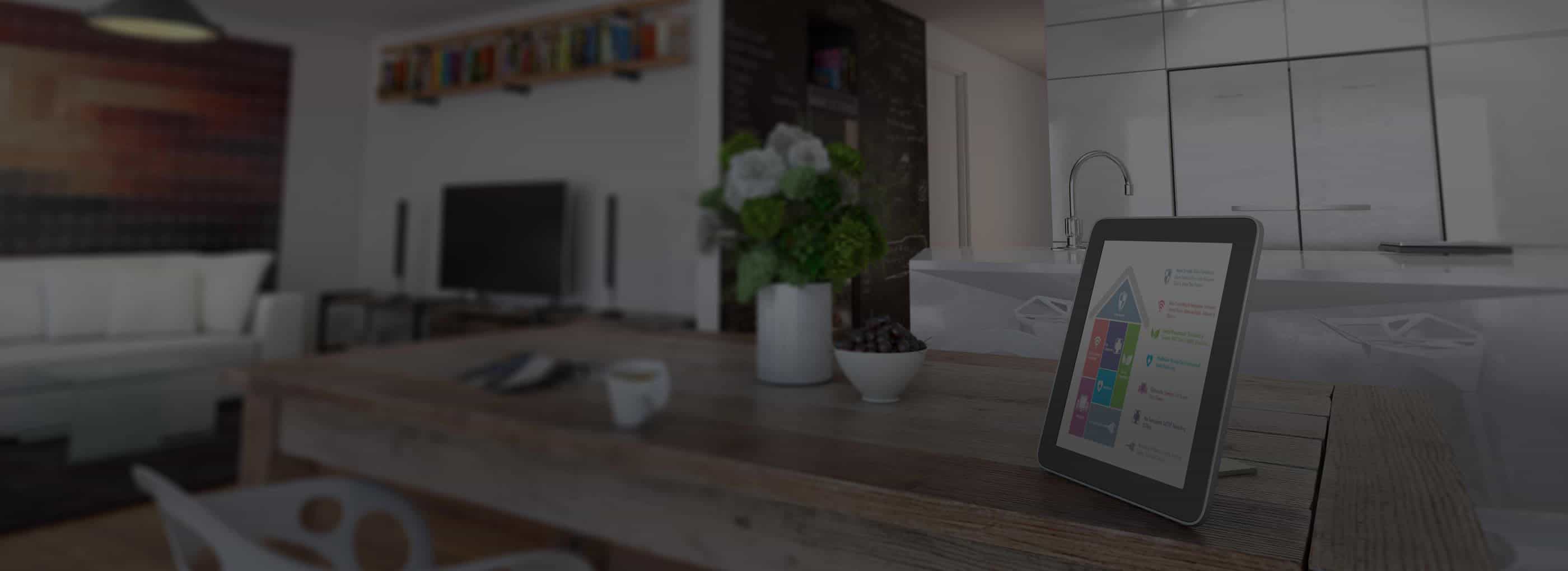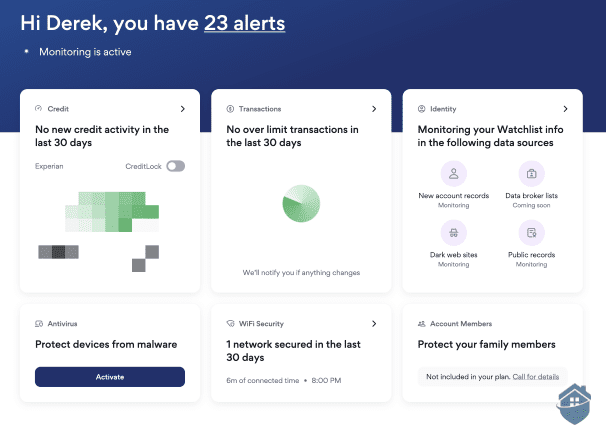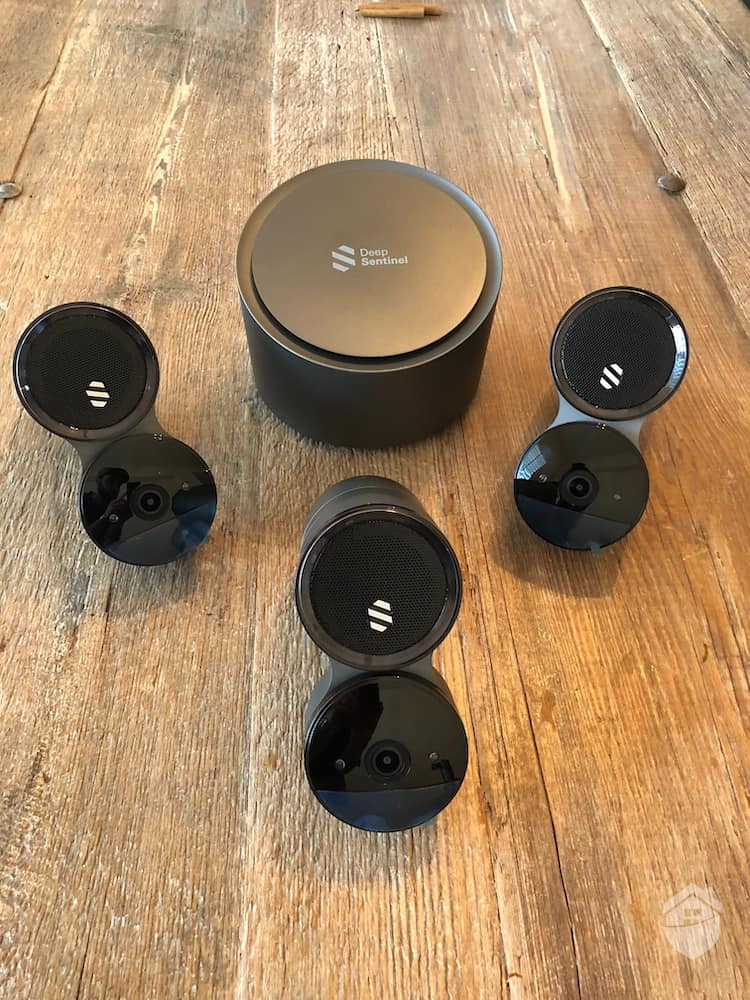Security cameras use two approaches to process video data: edge and cloud processing. Edge processing analyzes video within the camera or a local hub. Cloud processing sends your footage to remote servers for analysis. And each approach has pros and cons relating to privacy, monthly costs, and system reliability.
We tested over 30 smart cameras to see how these processing methods affect real-world performance. In this guide, we’ll break down the technical differences in plain English and share our recommendations on the best cameras in both categories. Let’s begin!
What Is Edge Processing in Smart Cameras?
Edge processing means your smart camera performs video analysis within the camera itself or on a nearby hub device. Instead of sending raw footage to servers, the camera’s built-in processor identifies people, vehicles, packages, and other objects.
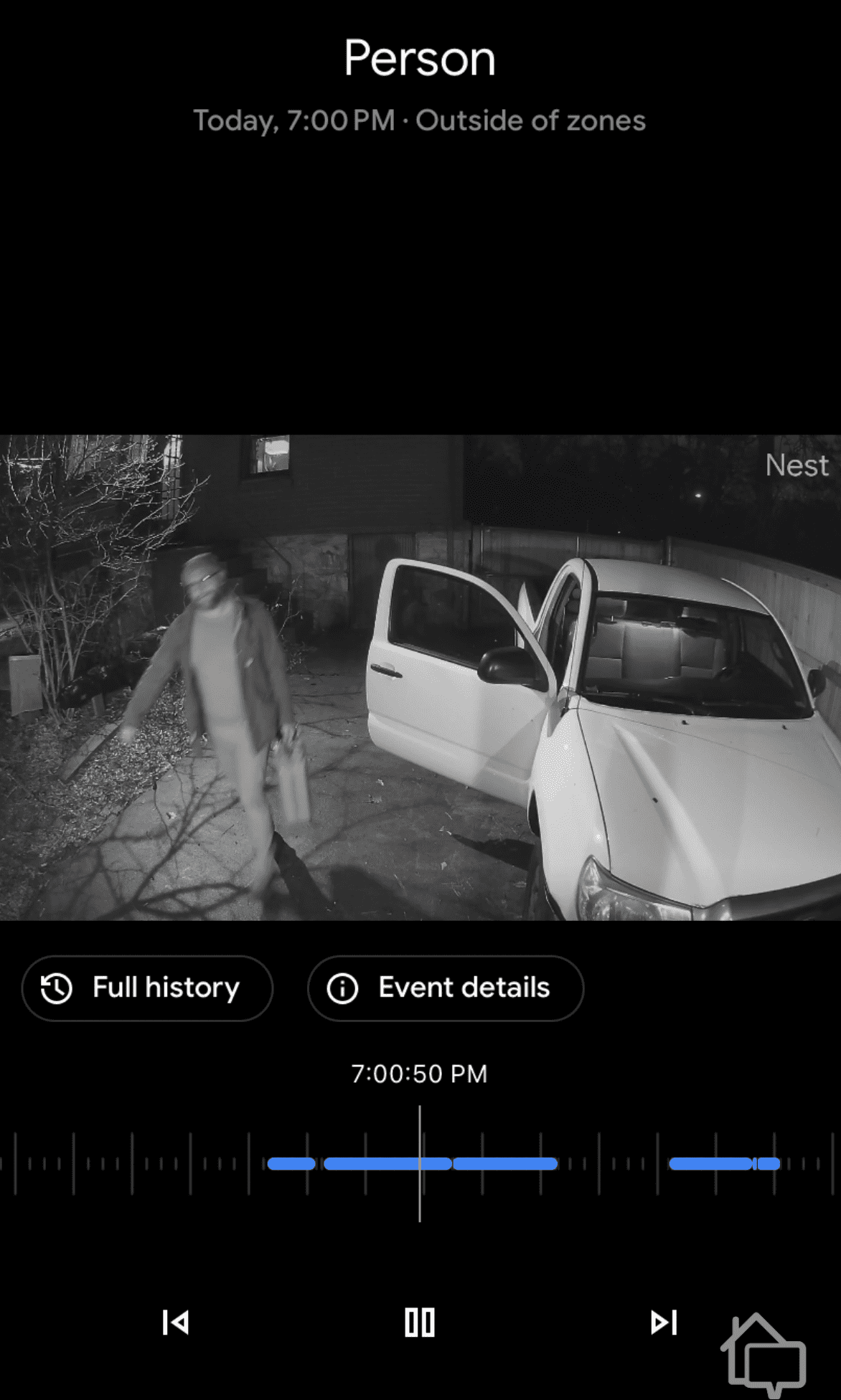
Our Nest Cam can distinguish between people we know and delivery drivers.
Modern edge-processing cameras contain specialized chips called neural processing units (NPUs) or AI accelerators. These components can distinguish between a person walking up your driveway and a tree branch swaying in the wind, all without an internet connection.
Expert Tip: If you prefer edge processing, look for cameras that specify “local AI processing” or “on-device analysis” in the product descriptions.
How Edge Processing Works
When motion triggers your camera, it immediately begins analyzing the video stream using internal algorithms. The camera compares what it sees against trained models stored in its memory, identifying specific objects or behaviors within milliseconds.
For example, when we tested Nest Cams, our camera correctly sent us a people notification for someone delivering a package and an animal notification when our neighbor’s cat strolled by. While Nest Cams need an internet connection to fully function, smart motion detection is processed locally for privacy and speed.
>> Compare: The 3 Best Nest Cam Alternatives
Edge Processing Benefits
In our testing, we noted three main benefits of processing and analyzing video footage locally:
- Faster Response Times: Local processing eliminates the delay caused by uploading footage to remote servers. During our tests, notifications arrived up to five seconds faster compared to cloud-based systems.
- Reliability: Cameras that use cloud-based processing are reliant on the internet. No internet, no processing. Some edge processing cameras, however, continue recording and analyzing footage during internet outages.
- Privacy and Data Control: Your video footage never leaves your property, which eliminates concerns about data breaches at third-party servers or unauthorized access to your recordings, which is what allegedly happened at Ring in 2018.1
Edge Processing Limitations
We also noted a few limitations compared to cameras that use cloud processing.
- Limited Processing Power: Complex analysis tasks that cloud servers handle easily may overwhelm local processors. That’s because cloud servers have several times higher processing power than smart cameras with on-board processing.
- Higher Upfront Costs: Edge-processing cameras with powerful built-in processors can cost between $50 and $150 more than comparable cloud-dependent models.
- Software Update Limitations: Adding new detection capabilities often requires hardware upgrades rather than simple software updates.
What Is Cloud Processing in Smart Cameras?
Cloud processing sends your camera’s video feed to remote data centers for analysis. The device functions mainly as a recording device, while the “smart” analysis happens on the security company’s cloud servers.
These remote servers possess significantly more processing power than any home device. They can simultaneously analyze thousands of video streams, applying sophisticated algorithms that would overwhelm local camera hardware.
>> Check Out: The Best Cloud Storage Home Security Cameras of 2025
How Cloud Processing Works
When your camera detects motion, it immediately begins uploading video clips to cloud servers. These servers analyze the footage using advanced machine learning models. They then send notifications and processed results back to your smartphone app.
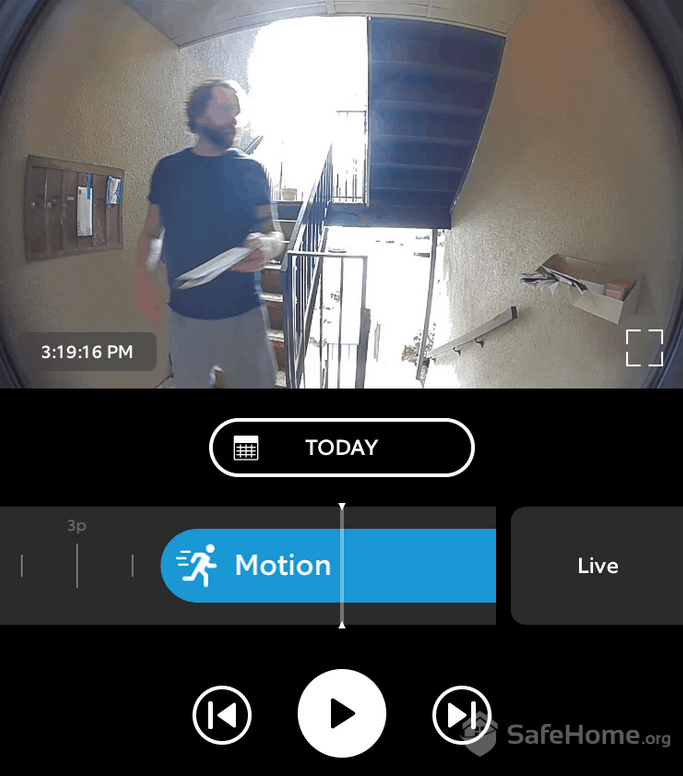
Adding a wired Ring Doorbell helped us monitor our package deliveries and prevent package theft.
We saw cloud processing in action while testing the Ring Video Doorbell Pro 2. Motion detection triggered local recording, the camera uploaded a 30-second clip to Ring’s servers, cloud analysis identified the visitor as a person carrying a package, and we received a detailed notification. This all happened within 8 to 12 seconds. Not bad.
FYI: Many cloud cameras offer basic live viewing for free. If you want motion alerts and recorded footage analysis, you’ll need to sign up for a subscription.
Cloud Processing Benefits
Despite some flaws, cloud processing security cameras have advantages over edge processing devices. Here are the top benefits:
- Advanced AI Capabilities: Remote servers can run sophisticated algorithms that recognize specific faces, identify unusual behaviors, and even detect audio anomalies like breaking glass.
- Unlimited Analysis Power: Cloud systems can process multiple video streams simultaneously without a drop in performance.
- Continuous Updates: New detection features arrive through software updates without requiring hardware changes or purchases.
Cloud Processing Limitations
Cloud processing cameras do have some drawbacks. These are some of the limitations we noticed:
- Internet Reliance: Cloud cameras become largely non-functional during internet outages, losing analysis capabilities and remote access.
- Privacy Concerns: Your footage travels to and is stored on remote servers, creating potential exposure to data breaches or unauthorized access.
- Slower Response Times: Uploading footage and receiving analysis results takes longer than local processing, typically adding 3 to 8 seconds to notification delivery.
Key Differences: Edge vs. Cloud Processing
To make it easier for you to compare, here’s how we assessed whether edge and cloud processing were right for our needs.
| Feature | Edge Processing | Cloud Processing |
|---|---|---|
| Data Privacy | High – footage stays local | Lower – data sent to third parties |
| Internet Dependency | Low – works offline | High – requires constant connection |
| Processing Power | Limited by hardware | Virtually unlimited |
| Response Speed | 1-3 seconds | 4-12 seconds |
| Setup Complexity | Moderate | Simple |
| Upfront Cost | Higher hardware cost | Lower hardware cost |
Privacy and Security Considerations
Privacy is the biggest difference between edge and cloud processing, so understanding how each method handles your personal videos can help you make the right choice. So let’s dive into that now.
Edge Processing Privacy Advantages
Edge systems keep your footage entirely within your home network. This eliminates several privacy risks compared to cloud-based systems. Data breaches cannot expose your footage if it never leaves your property. Your videos are also protected against unauthorized access (such as by the manufacturer’s employees or cloud server’s operator). Plus, government requests for footage must go through you directly rather than through corporate intermediaries.
Expert Tip: Even with edge processing, make sure your home network has WPA3 encryption and strong passwords to keep camera feeds secure.
Cloud Processing Privacy Considerations
Cloud systems require trusting third-party companies with your most sensitive video data. Fortunately, many of them offer professional-grade data centers with backup power, redundant storage, and dedicated security teams. Despite these measures, data breaches affecting major cloud providers occur regularly.
For example, Google’s Nest cameras have experienced security incidents where users could access other customers’ camera feeds due to software glitches.2 Ring, owned by Amazon, has also faced scrutiny for providing law enforcement agencies with customer footage without warrants in emergency situations.3
Cost Analysis: Upfront vs. Ongoing Expenses
Another differentiating factor between edge and cloud-based processing is the cost. It’s not just the hardware cost, though, but the ongoing operational cost as well.
Edge Processing Costs
Smart cameras with on-board processing require a higher entry cost. Prices average between $800 and $1,200 upfront, including at least two cameras, local storage, and networking equipment. Extra costs may include periodic storage device replacement and hardware upgrades for new features.
However, there’s no on-going cost for the processing functions. Since everything is done locally, you won’t need to pay a subscription to keep the “smart” features running. Lorex and Swann (pictured below) are great examples. Some of their DVRs offer local processing capabilities and local storage, so there’s no need to sign up for a cloud plan at all.
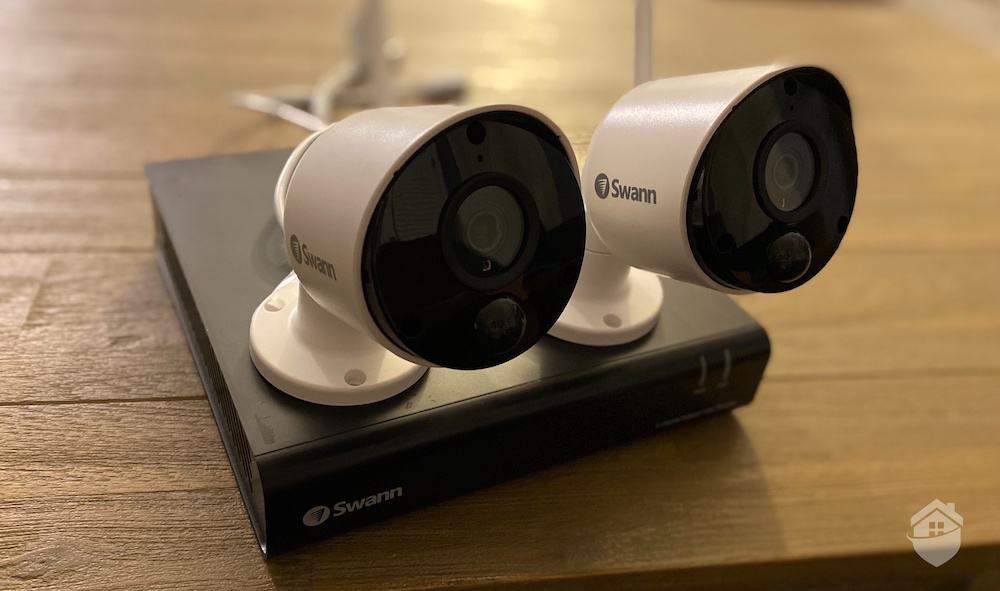
Swann cameras offer local storage, but this increases the overall costs.
Cloud Processing Costs
Cloud systems offer lower entry costs but include substantial subscription fees over time. Device costs can range between $400 and $600 initially, which should include two or more security cameras.
That said, cloud-dependent smart cameras typically require a subscription that packages together cloud storage fees and more advanced AI features such as facial recognition. Cloud subscription costs typically range between $5 to $15 per month. Because of this, security camera systems that use cloud processing can be two to three times more expensive than edge cameras in five years time.
Budget Tip: We recommend calculating total ownership costs over three to five years rather than focusing solely on upfront prices. Cloud subscriptions add up quickly across multiple cameras.
Hybrid Solutions and Cost Optimization
Some manufacturers offer hybrid approaches that combine local and cloud processing. These systems include simpler functions processed locally (e.g. person, pet, and vehicle detection) and optional, more advanced features processed on the cloud (e.g. facial recognition).
Nest Cams, for example, don’t need a cloud subscription to be able to tell apart humans, pets, and vehicles. They can do that out-of-the-box and without a Nest Aware subscription. If you add Nest Aware ($8 to $15 per month), you’ll get facial recognition and cloud storage. However, it’s worth noting that Nest Cams can only store recordings with a Nest Aware plan.
>> Learn More: How Does Motion Detection Work?
Performance and Reliability Factors
Our extensive hands-on testing also found there to be a difference in real-world performance and reliability between smart cameras that process videos locally and on the cloud. Let’s break it down next.
Reliance On the Internet
Cloud processing requires consistent, high-speed internet connectivity. We found that upload speeds below 2 Mbps per camera can cause delayed notifications and reduced video quality. That’s for 1080p HD security cameras. 2K and 4K cameras require higher upload speeds — at least 15 Mbps per camera.
In comparison, smart cameras with local processing only need minimal internet bandwidth for remote viewing and notifications. We still recommend an upload speed of at least 2 Mbps for 1080p cameras and 15 Mbps for 4K cameras, but local processing is more forgiving to internet slowdowns. Additionally, local processing continues to work during internet outages.
FYI: We experienced an internet outage while testing Lorex cameras (which process video locally using a DVR). During that time, we didn’t receive any notifications at all and couldn’t view live videos remotely using the app. We checked the DVR after the outage, and it still recorded event clips and tagged them correctly as people, pet, and vehicle events.
Processing Speed and Accuracy
Cloud servers deliver superior accuracy for complex recognition tasks such as facial recognition. Advanced algorithms running on powerful server hardware can distinguish between family members, identify unusual behaviors, and detect subtle audio cues (e.g. sound of glass breaking). These tasks are typically challenging for local processors.
However, edge processing provides faster initial response times. Local analysis begins immediately upon motion detection, while cloud systems must upload footage before analysis starts.
As for accuracy, cloud processing was slightly better at identifying people, vehicles, and packages. We also saw lower false positive rates. Here are the results from our side-by-side tests:
- Person detection: Edge 94%, Cloud 97%
- Vehicle identification: Edge 89%, Cloud 94%
- Package detection: Edge 91%, Cloud 96%
- False positive rate: Edge 8%, Cloud 4%
Choosing the Right Option for Your Home
Deciding between edge and cloud processing depends on your specific needs, technical comfort level, and long-term security goals.
Choose edge processing if you:
- Prioritize privacy and data control above all other factors
- Have unreliable internet service or experience frequent outages
- Feel comfortable managing local storage and performing basic maintenance
- Plan to install cameras in sensitive areas like bedrooms or home offices
- Live in areas with strict privacy regulations or HOA requirements
Edge processing works particularly well for tech-savvy homeowners who value data sovereignty and don’t mind investing more upfront for long-term savings.
Choose cloud processing if you:
- Want the most accurate AI analysis and advanced detection features
- Prefer simple setup and automatic maintenance without technical involvement
- Need professional monitoring integration for comprehensive security coverage
- Have reliable high-speed internet with consistent upload bandwidth
- Want unlimited storage without managing local devices
- Value continuous feature updates and cutting-edge capabilities
Cloud processing suits homeowners who prioritize convenience and advanced features over data privacy concerns and ongoing costs.
How to Get Started
Our testing confirms that both edge and cloud approaches provide effective home security when properly implemented. Edge systems excel in privacy-sensitive applications and areas with unreliable internet, while cloud systems deliver superior accuracy and advanced features for users with consistent broadband connectivity.
Consider starting with whichever approach aligns with your primary concerns. Don’t forget about hybrid approaches, which combine both methods based on specific camera locations and use cases. Regardless of your choice, ensure you select systems from reputable manufacturers that provide regular updates and long-term support for your home security investment.
Frequently Asked Questions
- Can I switch from cloud to edge processing later without buying new cameras?
Most cameras are designed for either cloud or edge processing and cannot switch between methods.
- How much internet speed do I need for cloud-processing cameras?
Cloud cameras typically require 1-2 Mbps upload speed per camera for reliable operation. Check your internet plan’s upload speeds, which are often much lower than download speeds.
- Are edge-processing cameras harder to hack than cloud cameras?
Edge cameras have smaller attack surfaces since they don’t connect to third-party servers, but they’re still vulnerable to network-based attacks. Both approaches require strong passwords and regular updates for security.
- What happens to my cloud-stored footage if the company goes out of business?
Company closure typically means permanent loss of cloud-stored footage and service discontinuation. Edge systems with local storage remain functional regardless of manufacturer status.
- Can edge-processing cameras work with smart home systems like Alexa or Google Home?
Many edge cameras support smart home integration, though features may be limited compared to cloud-based systems. Check specific compatibility before purchasing.
- Do edge-processing cameras use more electricity than cloud cameras?
Edge cameras typically consume slightly more power due to local processing requirements, but the difference is usually minimal. Solar-powered options are available for both processing types.

